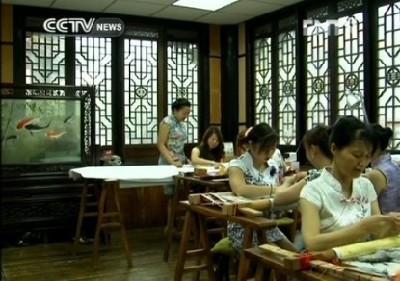At her studio near Chengdu’s Wenshu Temple, Meng takes us through the painstakingly meticulous work required to create each piece. For some works, many layers of embroidery are needed and the detail required to create delicate facial features, for example, is astonishing. Here one silk thread is divided into thirty pieces, with each part thinner than hair. She tells us the double-faced embroidery, with different pictures on two sides, is a unique technique only seen in Shu embroidery.

“On this side there is a dragon, while on the other side is a phoenix. The cloud is embroidered here to make the two sides match,” Meng Dezhi said.
Meng Dezhi has been honored as the nation’s designated inheritor of this craft and has also been awarded the highest honor in craft making in China, the "National-class Master Craftsman". In 2006 she was invited to open a studio in Wenshu Street, the historical and tourist centre in Chengdu. She says this was a turning point in her career.
With high quality Shu Embroidery pieces more and more in demand, Meng has had to grow her business along the way, to satisfy the increasing need of this time-consuming craft.

“The orders for our high-end works will take us years to get through, so we’ve recruited some skilled people today. We have to foster more talent in our workshops to cater to the demand,” Meng said.
Meng’s five training bases in Chengdu now turn over an annual profit of 3 million yuan. Their works take on not only traditional themes such as birds, flowers and animals, but also ancient paintings or modern oil paintings. Last year, Meng’s work "Autumn Plateau" was hung in a hall at "the Great Hall of the People" in Beijing. To Meng, this honor is testimony that Shu Embroidery is appreciated by the people and is still very much alive and kicking.
